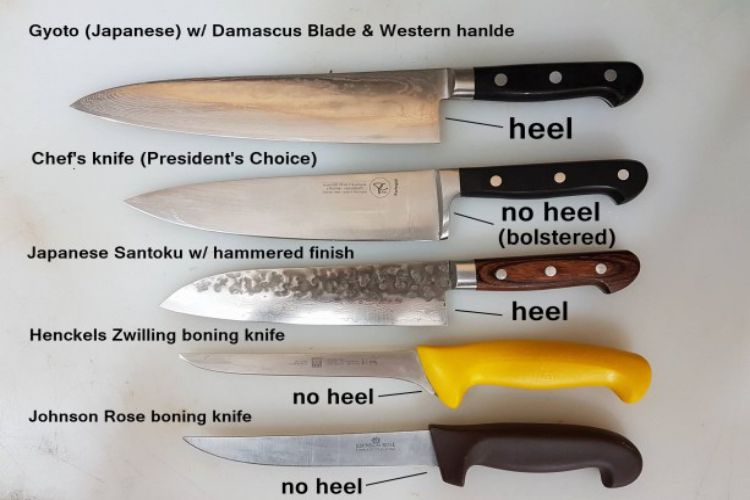 In order to be a successful chef, amateur, or professional you need the right tools. A kitchen knife is one of the most important items in your arsenal. It’s not just about how sharp it is or what type of material it’s made from either. Other things to consider are the shape and size, which will dictate the jobs you’ll be using it for in the kitchen. You should also know about the different parts of a kitchen knife and how each of them contributes to the overall whole. In this blog post, we will discuss all the different parts that make up a kitchen knife and why it is so important for chefs to understand them fully!
In order to be a successful chef, amateur, or professional you need the right tools. A kitchen knife is one of the most important items in your arsenal. It’s not just about how sharp it is or what type of material it’s made from either. Other things to consider are the shape and size, which will dictate the jobs you’ll be using it for in the kitchen. You should also know about the different parts of a kitchen knife and how each of them contributes to the overall whole. In this blog post, we will discuss all the different parts that make up a kitchen knife and why it is so important for chefs to understand them fully!
Why kitchen knives are important for chefs
As a chef, your kitchen knives will be your most useful tools, even more than your pans. They are what you will use to cut, slice, and chop all of your ingredients. This is an important task because you will want uniformly-sized and shaped pieces of food that will cook at the same rate. This is why it’s important to make sure you have a good knife and know how to use it properly!
Things to consider when buying new kitchen knives
There are many different things one should consider before purchasing their next kitchen knife such as, size (do you want something big for chopping or small for slicing?), material (is stainless steel the best choice? What about ceramic?), and brand. There is a lot that goes into choosing your next kitchen knife so it’s important to do some research beforehand! You’ll need to think about what you’re going to use it for, what your budget is, how you will store your new knife, and also would it be better to buy a single knife, multiple individual knives, or a complete kitchen knife set? Where the knives are made will also be important with Japanese knives contrasting with more Western knife styles.
All the different parts of a kitchen knife
When looking at an image of a typical chef’s knife you will see that there are many different parts to it. You might not realize but the design and construction methodology that has gone into each of them will affect how the knife feels in your hand and performs overall.
Handle
The handle of a kitchen knife can be made out of various materials depending on price point, brand preference, etc.. This part not only helps you hold onto the blade but also ensures that you won’t cut yourself while using the knife.
Tang
The tang is the part of a kitchen knife that goes into the handle and it typically extends all the way to where your fingers grip onto it. This helps with balance, stability, strength, and weight which will lead to better performance when in use.
Butt
The butt of the handle is at the very bottom of the knife and maybe shaped for comfort.
Rivets
These are small cylindrical pieces of hardware that attach the tang, butt, and handle together. This helps to keep everything sturdy and secure while making sure the handle doesn’t fall off!
Bolster
The bolster is a piece of metal that separates the blade from the handle. This ensures there’s little risk of cutting yourself on either part which makes it safer to use as well as more comfortable in your hand when chopping and slicing away!
Heel
The heel is the thicker part of the blade that helps with chopping or cutting large chunks.
Spine
The spine is the opposite side of the blade to where you hold it. This gives your hand a place to rest when using the knife which will lead to better technique and less fatigue in your hands!
Blade
The blade is arguably the most important part of a knife. It’s what you will be cutting with and it does all the work!
Edge
The edge of the blade is what makes contact with your ingredients. This will determine how sharp or blunt your knife is as well as how it will feel when in use. A sharper kitchen knife means that there’s less risk of bruising, tearing, shredding, or chopping food which can be important for cutting up your vegetables, fish, and meat into smaller pieces, like if you’re making sushi, for example.
Tip
The tip is typically pointier on kitchen knives than other types such as pocket knives, hunting knives, or daggers. This means that you can make really fine cuts while also having more control over your cuts and slices!
Point
The point is the very tip of your kitchen knife and can be used to make small, accurate, or delicate cuts.
Conclusion
Kitchen knives are an essential part of any kitchen. They can help you out in a variety of ways such as chopping, slicing, or carving your ingredients into the perfect size and shape for cooking. As with all tools, it is important to know what they’re made from and how to use them properly! In this blog post, we’ve talked about some different parts that make up a kitchen knife which may be helpful if you ever need to buy a new set or single blade.


